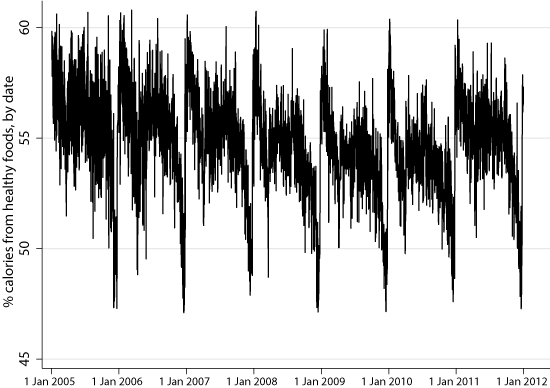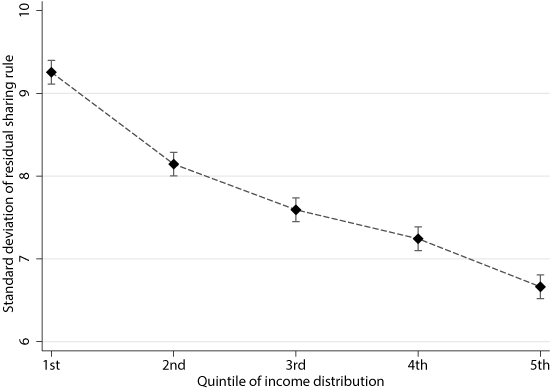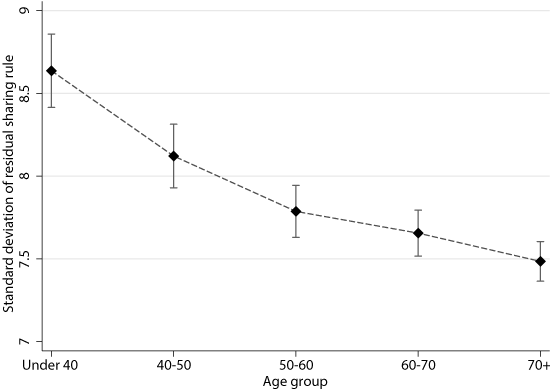“New Year’s Day ... now is the accepted time to make your regular annual good resolutions. Next week you can begin paving hell with them as usual.”
– Mark Twain
A growing theoretical literature posits that people sometimes make decisions that they later regret. The existence of self-control problems opens the possibility that public policy may be able to improve welfare, for example, by increasing the cost of consumption today to reflect future unanticipated costs, or by facilitating the use of commitment devices (e.g. Gruber and Koszegi 2004, Bernheim 2009).
A leading example of a setting in which self-control problems may play a role is in food consumption. Evidence from the experimental literature (e.g. Read and Van Leeuwen 1998, Gilbert et al. 2002) and the existence of a multi-billion dollar diet industry (Cutler et al. 2003) attest to this. Considerable attention has been paid to variation in diet quality across individuals and the impact this has had on rising obesity and diet-related disease (e.g. Finkelstein and Zuckerman 2008, Baum and Ruhm 2009). However, much less attention has been paid to the variation in diet quality within-person over time, and whether this is reflective of self-control problems.
There is limited direct evidence on self-control problems from observational consumption data. This is, in part, because convincing evidence requires separating out variation in food purchases due to self-control problems from variation that arises due heterogeneity in individuals’ preferences for different foods and in how they respond to changes in the economic environment. In a recent paper (Cherchye et al. 2017), we combine detailed longitudinal data on British individuals’ food purchases with an empirically tractable framework to provide empirical evidence on the existence and size of, and variation in, self-control problems in food choice.
There is large within-person variation in diet quality over time
People’s tendency to make (and fail to keep) New Year’s resolutions to lead more healthy lifestyles indicates the potential importance of within-person variation in diet quality over time. Figure 1(a) shows data from Google Trends for the US and the UK over time for searches for “diet” – there are spikes in January, with steady declines as the year progresses. Figure 1(b) shows contemporaneous patterns in the share of calories purchased from healthy foods. There is, on average, a decline of over 10 percentage points in the share of calories purchased from healthy foods over the calendar year. This is a sizeable change – for the average shopping basket it is approximately equivalent to cutting the calories from chocolate, sweets and cake in half, and doubling the calories from fruit.
Figure 1 Google Trends data
(a) Google searches for “Diet”
(b) % calories from healthy foods, 2005-11
Although there is a clear aggregate trend in diet quality over the calendar year, this masks a great deal of heterogeneity in within-person variation. January is the healthiest month for only around one-third of individuals; the healthiest month for the remaining two-thirds is roughly evenly spread over the rest of the year, with October, November, and December being the months that are least often the healthiest. Similarly, roughly one-third of individuals purchase their least healthy grocery basket in December, but the remaining two- thirds buy their least healthy basket in a different month.
On average, the within-person standard deviation in the share of calories from healthy food is around 10 percentage points; but it is less than 6 percentage points for 5% of individuals, and more than 14 percentage points for 5% of individuals. This variation may be driven by temptation and self-control problems, but it could also reflect rational responses to changes in the economic environment. This motivates the need to develop a model of food choice that we can take to data and that can accommodate the considerable heterogeneity in preferences that are a clear feature of the data.
A two-selves model of food purchasing behaviour
A popular way of modelling self-control problems in the theoretical literature is the multi- selves model, dating back to Strotz (1955) and Peleg and Yaari (1973). We bring together the insights from this literature with the literature on collective household behaviour (e.g. Chiappori 1988, 1992). In our model, individual choice is driven by the influence of a healthy self and an unhealthy self, which are both characterised by their own stable and well-behaved preferences. The healthy self derives utility only from healthy foods, and the unhealthy self derives utility only from unhealthy foods. The two selves enter a bargaining process that is different for every individual, and which may not be stable over time. A more resolute individual is one whose bargaining process is stable over time. We focus on within- person variation in the bargaining power of the two selves as potentially indicative of the existence of self-control problems.
We check whether the theoretical implications of our two-selves model are satisfied for our data by making use of revealed preference methods in the tradition of Samuelson (1938), Afriat (1967) and Varian (1982). These methods are consistent with a very general class of demand models, so long as the two selves have stable and well-behaved preferences. They allow us to check behavioural consistency with the two-selves without imposing auxiliary parametric assumptions such as homogenous preferences. The two-selves model does a good job at explaining variation in the data, and a better job than a single-self model, in which each individual is characterised by a single, stable utility function.
Younger and lower income individuals suffer more from self-control problems
An important feature of our model is the sharing rule – the share of the food budget allocated to healthy foods. Chiappori (1988) shows that the sharing rule is a direct indication of the bargaining power of the healthy self. We show that consumers with a higher average sharing rule are more likely to state that they try to eat a healthy diet, and are less likely to state that they have tastes for processed foods.
Around 20% of the within-person variation in the sharing rule can be explained by responses to changes in prices or food budgets. Seasonality in preferences does not explain the remaining variation. The remaining portion remains unexplained by individuals’ response to the economic environment and is indicative of self-control issues. We find that the degree of fluctuations in individuals’ sharing rule is correlated with their stated attitudes in ways that support our interpretation. For example, individuals who state that they regularly make a shopping list and commit to buying the same brands exhibit relatively small fluctuations. On the other hand, individuals who state that they often spend money without thinking, or spend more on their credit card than they should, have larger fluctuations in their sharing rule.
Figure 2(a) shows how the within person standard deviation of the ‘residual’ sharing rule (i.e. the part left after removing the influence of responses to changes in the economic environment) varies with income, showing that lower-income individuals have greater fluctuations in their sharing rule. This is consistent with the hypothesis that self-control may be causally related to poverty (e.g. Bernheim et al. 2015). Figure 2(b) shows that younger individuals also suffer more from self-control problems, a finding consistent with evidence from the literature on savings (e.g. Ameriks et al 2007).
Figure 2 Standard deviation of the residual sharing rule
(a) By income
(b) By age
Conclusions
In this column, we have described how longitudinal data on individuals’ food purchases can be combined with an empirically tractable framework to provide evidence on self-control problems in food purchasing. An important feature of our model is that we allow for heterogeneity in individuals’ food preferences and in the way they respond to changes in the economic environment. Our results indicate that self-control problems in food purchases are important.
While many of the existing theoretical multi-selves models yield observationally equivalent predictions about behaviour, they do have differing implications for welfare. In this work, we remain agnostic about the specifics of the interactions between the two selves and therefore do not make statements about welfare. Our findings suggest that a more detailed investigation of the particular interaction mechanisms at play constitutes a potentially important avenue for follow-up research.
References
Afriat, S N (1967), “The construction of utility functions from expenditure data”, International Economic Review 8(1): 67–77.
Ameriks, J, A Caplin, J Leahy T and Tyler (2007), “Measuring self-control problems”, The American Economic Review 97(3): 966-972.
Baum, C L and C J Ruhm (2009), “Age, socioeconomic status and obesity growth”, Journal of Health Economics 28 (3): 635–648.
Bernheim, B D (2009), “Behavioral Welfare Economics”, Journal of the European Economic Association 7(2-3): 267–319.
Bernheim, B D, D Ray and S Yeltekin (2015), “Poverty and Self-Control”, Econometrica 83(5): 1877–1911.
Cherchye, L, B De Rock, R Griffith, M O’Connell, K Smith and F Vermeulen (2017), “A new year, a new you? Heterogeneity and self-control in food purchases”, CEPR Discussion Paper No. 12499.
Chiappori, P-A (1988), “Rational household labor supply”, Econometrica 56(1): 63–90.
Chiappori, P-A (1992), “Collective labor supply and welfare”, Journal of Political Economy 100(3): 437–467.
Cutler, D, E Glaeser and J Shapiro (2003), “Why Have Americans Become More Obese?”, Journal of Economic Perspectives 17(3): 93–118.
Finkelstein, E A and L Zuckerman (2008), The Fattening of America: How The Economy Makes Us Fat, If It Matters and What To Do About It, Wiley.
Gruber, J and B Koszegi (2004), “Tax incidence when individuals are time- inconsistent: The case of cigarette excise taxes”, Journal of Public Economics 88(9-10): 1959–1987.
Peleg, B and M E Yaari (1973), “On the Existence of a Consistent Course of Action when Tastes are Changing”, Review of Economic Studies 40(3): 391.
Read, D and B Van Leeuwen (1998), “Predicting hunger: The effects of appetite and delay on choice”, Organizational Behavior and Human Decision Processes 76(2): 189–205.
Samuelson, P A (1938), “A Note on the Pure Theory of Consumer’s Behaviour”, Economica 5(17): 61–71.
Strotz, R H (1955), “Myopia and inconsistency in dynamic utility maximization”, Review of Economic Studies 23(3): 165–180.
Varian, H R (1982), “The nonparametric approach to demand analysis”, Econometrica 50(4): 945–973.












